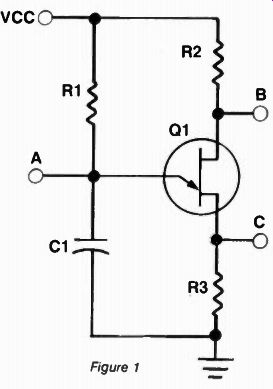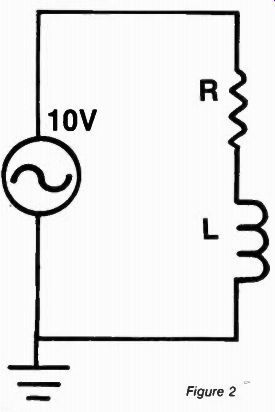This is the seventh of ET/D CET Quizzes. If you have done well it is about time to consider taking the CET Examination.
by Frank K. Egner, CET
Here's the next CET test preparation quiz on electronic fundamentals. If you are making passing scores on these quizzes, you should be ready to take the CET Associate exam. The questions you are missing may indicate those areas where reviewing would be helpful. The last six questions of this quiz relate to the NTSC standards for color TV transmission and reception. Each future quiz will include some questions on TV or other home entertainment or industrial devices.
CET exams can only be administered by CET Certification Administrators. A fee is required to cover expenses of administration, grading, and issuance of certificates.
However, if both the Associate exam and one Option exam are taken at one time, they count as one exam.
Contact the Certification Administrator of The Electronics Technician's Association or The International Society of Certified Electronics Technicians in your area. The national headquarters addresses for both have been given in previous issues of ET/D.

Figure 1
The passing score for all CET exams, and these quizzes is 75%. Good testing!
1. A transmitter operating on 0.15 GHz radiates a wavelength of:
a. 0.5 meter.
b. 1.0 meter.
C. 1.5 meter.
d. 2.0 meters.
2. In figure 1, Q1 is a:
a. JFET.
b. MOSFET.
c. UJT.
d. SCR.
3. The output frequency of the device in figure 1 is primarily controlled by:
a. The input signal.
b. R1 and C1.
c. C1 and R3.
d. The VCC voltage.
4. A scope connected to terminal B in figure 1 would display:
a. The amplified input at C.
b. A ramp voltage.
c. A negative pulse train.
d. A positive pulse train.
5. In figure 1 the name of the Q1 terminal at C is:
a. Base 1.
b. Emitter.
c. Source.
d. Cathode.
6. In figure 1 when terminal A is forward biased with respect to terminal C:
a. A positive pulse appears at B.
b. A negative pulse appears at C.
c. Capacitor C1 charges.
d. A to C develops negative resistance.
7. 10 one-half watt resistors, color-coded brown, black, brown, gold, are connected in parallel. An ohmmeter across the combination indicates normal conditions if it measures between:
a. 8.5 and 11.5 ohms.
b. 9 and 11 ohms.
c. 9.5 and 10.5 ohms.
d. 95 and 105 ohms.
8. The maximum current that can be passed by the combination in question 7 without overheating any resistance in tolerance is:
a. 69 ma.
b. 690 ma.
C. 72.5 ma.
d. 725 ma.

Figure 2 G OMM
9. Using scope measurements in figure 2, XL can be determined by EL/IL. This result is approximate because:
a. Coil resistance has been neglected.
b. The phase angle has not been considered.
c. Voltage and current are out of phase.
d. More than one but not all are correct.
10. In the RL circuit of figure 2:
a. EL plus ER equals 10v.
b. ER minus EL equals 10v.
c. 10v minus EL equals ER.
d. ER plus EL is over 10v.
11. In figure 2 decreasing the generator frequency will:
a. Increase the resistor voltage.
b. Increase the phase angle.
c. Increase the inductor voltage.
d. Decrease power dissipation.
12. Connecting a scope across L in figure 2 will display:
a. A differentiated sinewave.
b. A rectangular waveform.
c. A highly distorted sinewave.
d. None of these.
13. The cutoff frequency of a circuit occurs when:
a. The phase angle approaches 90 degrees.
b. The signal out is 0.707 the mid range signal.
c. Output power is 0.707 the mid range power.
d. The signal out is reduced by one half.
14. The product of applied voltage and total current in an ac circuit containing resistance and reactance is:
a. Real power.
b. Reactive power.
c. Apparent power.
d. True power.
15. In a high-Q parallel resonant circuit:
a. Line current is maximum.
b. Tank current is maximum.
c. EC equals Q times E_app.
d. The phase angle is maximum.
16. A 5-tube ac-dc radio uses one each 5005, 35W4, 1213E6, 12BA6, and 12AV6. If the 12BA6 filament burns out:
a. 0 v appears across the 12BA6 filament pins.
b. B + appears at all tube anodes.
c. 117v appears across the 35W4 filament pins.
d. 0 v appears across the 12AV6 filament pins.
17. Six tubes with 600 ma heaters are connected in series across the 120v line. Their filaments total 80v. What value resistor must be connected in series?
a. 67 ohms.
b. 6.7 ohms.
c. 670 ohms.
d. 6.7K ohms.
18. In question 17, what is the minimum wattage of the resistor?
a. 250 watts.
b. 25 watts.
c. 40 watts.
d. 10 watts.
19. Which of the following devices is most likely to be damaged by a static charge during handling?
a. MOSFET.
b. Bipolar transistor.
c. UJT.
d. SCR. 20. In color TV transmissions, the luminance signal is composed of:
a. 0.30G + 0.59R + 0.11B.
b. 0.59G + 0.30R + 0.11B.
c. 0.11G + 0.30R + 0.59B.
d. 0.59G + 0.11R + 0.3013.
21 When the color signal is transmitted as I and Q signals, the I and Q bandwidths are:
a. I =1.5MHz, 0=0.5MHz.
b. Q = 1.5MHz, I =0.5MHz.
c. Both I and Q = 1.5MHz.
d. Both I and 0 = 0.5 MHz.
22. In the reproduced TV picture, the brightness information is contained in the:
a. I and Q signals.
b. R-Y and B-Y signals.
c. Y signal only.
d. More than one but not all above.
23. A maladjusted receiver may display a 920 KHz (herringbone) interference pattern developed from the:
a. Video and sound carriers.
b. Video and color carriers.
c. Color and adjacent channel carriers.
d. Sound and color carriers.
24. The frequency and phase of the color oscillator is critical. A shift in oscillator phase can be detected by:
a. A change in the hue of the picture.
b. A change in color saturation.
c. The complete absence of one color.
d. A change in overall picture brightness.
25. Some color receivers demodulate I and 0 signals and others demodulate R-Y and B-Y signals.
The main difference in these demodulators is the:
a. Frequency of the 3.58 MHz oscillator.
b. Phase of the 3.58 MHz oscillator.
c. Both a and b are correct.
d. Neither a nor b is correct.
====
Answers to CET quiz:
1.d 6.d 11.a 16.d 21.a
2.c 7.c 12.d 17.a 22.c
3.b 8.b 13.b 18.b 23.d
4.c 9.a 14.c 19.a 24.a
5.a 10.d 15.b 20.b 25.b
(source: Electronic Technician/Dealer)